
| You are in: Observing Tool (OT) > Science Program > Viewer |
 |
The Science Program Viewer |
The science program viewer displays program and observation details in a hierarchical tree structure. This page gives further information about:
Consider the example science program shown below:
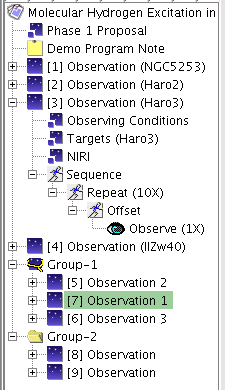 | 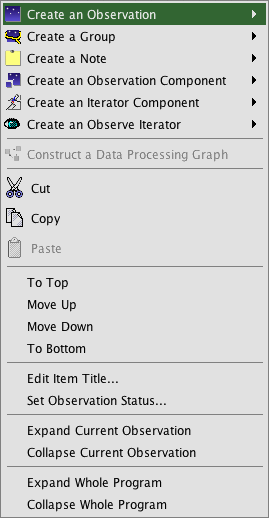 Right-click menu |
This science program consists of the main program summary (top level with the program title), the Phase 1 proposal, an upper-level note, and nice science observations.The number in square brackets to the right of each observation icon is the observation id number.
This
science program contains nine observations, three of which
(Observations 2, 1 and
3) have been grouped together into Group 1 and three of which (8 and 9)
are organized in a folder called Group-2. The tree structure for
three of the
observations (NGC5253, Haro2 and IIZw40) is shown in a collapsed form.
The structure of
Observation (Haro3) has been expanded by clicking on the expansion icon
 . to reveal the various components and iterators
that it contains. See more details of the individual
science program elements. To open the detailed editor for any element simply
left-click on it in the science program viewer (e.g. click on the name NIRI or on the icon
to its left).
. to reveal the various components and iterators
that it contains. See more details of the individual
science program elements. To open the detailed editor for any element simply
left-click on it in the science program viewer (e.g. click on the name NIRI or on the icon
to its left).
Right-click on any element in the science program editor to show which items can be added to a science program or observation from the currently highlighted item and other editing options (cut, copy paste, move up, down etc). Unavailable items are greyed out, as are the icons in the science program elements toolbar. You can also expand the current observation (i.e. all nodes in the tree structure) or expand the entire program from the right-click menu.
The science program contains a brief summary of the program information and status, accessed by selecting the very top of the program tree, and Phase I information copied from the approved proposal. For programs downloaded from the Gemini database both of these items are for information only and are not editable.
| The main program summary node, denoted by the program title at the top of the science program tree displays information such as PI contact details, the program title, Gemini reference information (e.g. program reference ID, NGO contact, Contact Scientist), proposal mode (classical or queue), queue band (if appropriate) and the total allocated, planned, charged, and remaining times. The allocated times are also shown on the queue or classical summary web page. At the bottom of the screen are tabs giving the fetch/store history of the program and a facility for storing and fetching attachments like finding charts and mask design files (see below). Some of this information, such as the PI contact info, can be changed. | 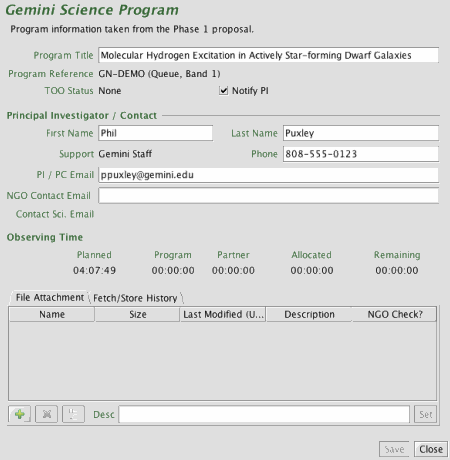 |
 ) in the
File Attachment tab. A file selection dialog then appears (see
below). Multiple files can be selected by either Shift-clicking or
Ctrl-clicking. Clicking Attach will then bring up a password
prompt where the appropriate program key should be entered for the
role of the user (PI, NGO, Gemini staff). A description of each
attachment should be added to help the observers and other Gemini
staff understand the attachments. The attachments can also be
downloaded or removed in a similar manner with the Fetch (
) in the
File Attachment tab. A file selection dialog then appears (see
below). Multiple files can be selected by either Shift-clicking or
Ctrl-clicking. Clicking Attach will then bring up a password
prompt where the appropriate program key should be entered for the
role of the user (PI, NGO, Gemini staff). A description of each
attachment should be added to help the observers and other Gemini
staff understand the attachments. The attachments can also be
downloaded or removed in a similar manner with the Fetch ( ) and Remove
(
) and Remove
( ) buttons. See the instructions on creating finding charts and GMOS mask
designs.
) buttons. See the instructions on creating finding charts and GMOS mask
designs.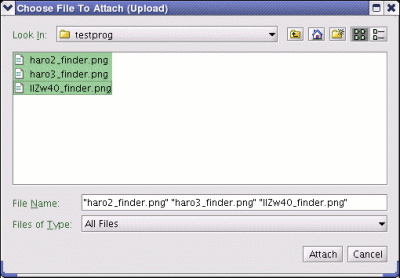 |  |
The ordering of the observations in the science program does not convey any prioritisation. The relative importance of individual observations within a program can be set using the low/medium/high priority flags in the detailed observation component editor. Thus, if this were a queue-scheduled program and all the targets had the same priority and the same (equally well-matched) observing condition constraints, the decision of whether to observe NGC5253, Haro2, Haro3 or IIZw40 first from the program above would be taken by the Gemini staff observer.
The scheduling group element enforces an execution sequence. Not only does it ensure that all observations within the group are executed in series but the hierarchy of the observations defines the order in which they would be observed. This is useful if you wish observation of specific calibration star(s) adjacent to the science target, for example. In the example science program above the execution sequence would be Obs 2, then Obs 1 and finally Obs 3. However, standard rules of Baseline calibrations still apply. For example, if two observations of telluric standards (before and after) with class Nighttime Partner Calibration are included in a group with one science observation, then only one of the calibrations will be executed if the total integration time on the science target is less than the time for which two baseline standards are required (see NIR baseline calibrations). If more calibration is needed than is provided by the baseline calibration plan, then additional observations with class Nighttime Program Calibration should be defined. In general, all observations with classes Science or Nighttime Program Calibration will be executed unless instructions to the contrary are provided in a Scheduling Note.
Often there are daytime calibrations (twilight flats or GCAL flats/arcs) associated with a particular group. Observations with class Daytime Calibration will be excluded from the nighttime observing plan so they can either be included in the scheduling group or in a separate folder.
The priority of observations within the group can be set in the same way as for un-grouped observations to indicate the priority of the entire group compared with any un-grouped observations. The priority of the scheduling group is set by the priority of the science observations.
Organizational folders (Group-2 in the example above) are for collecting related observations without any scheduling implications. All observation in a folder are scheduled separately.
More information on working with groups and folders is given on the Science Program Elements page and more examples are given in the OT libraries.
The observation element is the container for everything associated with an observation e.g. Observation (Haro3) is self-contained with observing condition constraints, science and WFS target list, instrument (NIRI) configuration and an telescope offset sequence. Normally the observation is the smallest schedulable element and corresponds to one telescope pointing. Thus each new science target, PSF or other calibration star must be defined as a separate observation. Likewise, each observation in the sequence star-object-star-object... must be a separate observation. However when observations are grouped, the group becomes the smallest schedulable entity. This means that execution of the group will only be started if there is time to complete it.
Observations and their constituents are added to the science program using the science program elements toolbar. You can also add elements by right-clicking; the list of available elements depends on which element is selected (highlighted) in the science program viewer. From the right-click menu (illustrated above) you can also cut, copy and paste program elements (subject to the usual rules about the observation contents). To change the order or observations in a group or of elements within the sequence folder use the move up, down, to top, to bottom items on the menu.
You can drag-and-drop elements within and between observations (e.g. to re-order the iterators in a sequence).
The sequence node contains the iterator and observe commands that define the series of actions to collect data (see details of the iterators and observe elements). It is possible to construct complex sequences using the iterators (and assumed in the following discussion that you have absorbed details of the individual iterators).
Sequence iterators can be nested, much like nested loops in a programming language. For each step of the top level iterator, the nested iterator cycles through all of its values. To illustrate this concept consider the following sequence containing an offset iterator and an observe (recall that the offset iterator defines a series of one or more telescope offset positions and the observe element takes data). The sequence folder contents are shown in figure (a) and the specific offsets, a 2x2 grid with 60 arcsec separation, in figure (b). In figure (c) we see the unwrapped sequence displayed by selecting the sequence folder.
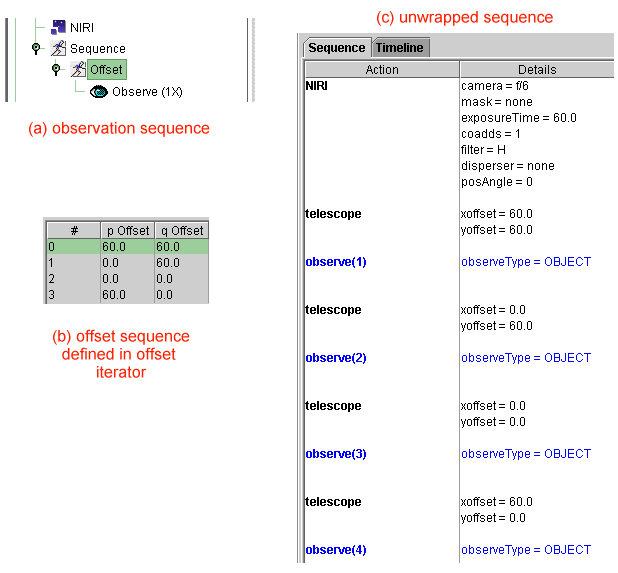
The offset, instrument and repeat iterators can be nested inside one another. Suppose we wanted to observe the same offset sequence in each of two NIRI filters (recall that the NIRI iterator allows any configurable items in the NIRI instrument component to be changed in a single step). The sequence below shows how this is done and the result: first we observe the two offset position in the Br(gamma) filter and then again in K-continuum.

Note that the effect of reversing the order of the iterators is to create a sequence that cycles through the filters at each offset position:
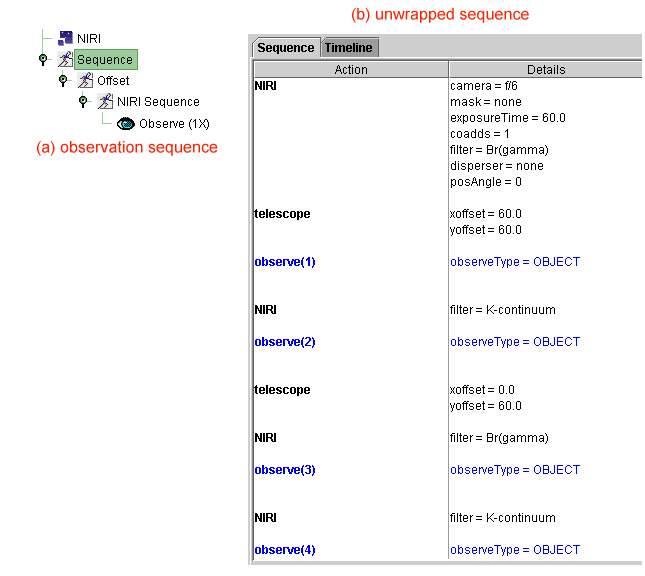
Last update June 8, 2008; Bryan Miller